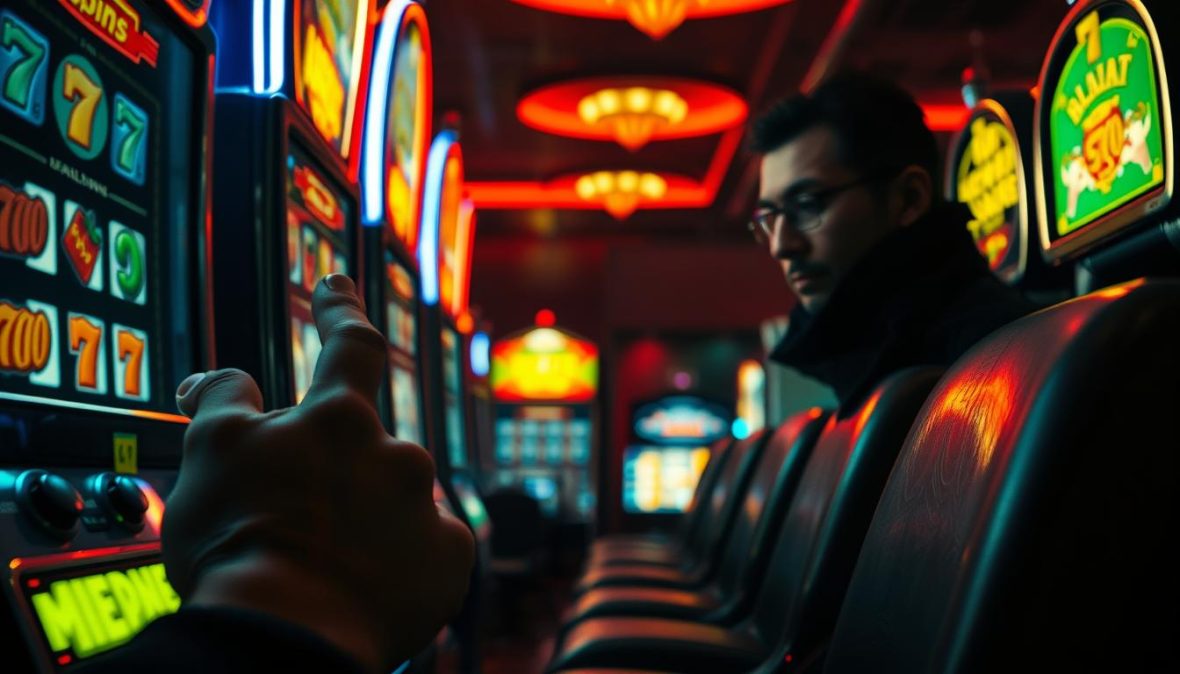Busting Common Slot Machine Myths: Tools, Evidence, and Source

Surprising fact: I’ll start with a clear number — when 100 people spin 1,000 times each you get about 10 top hits on average; with 1,500 people doing the same you see about 150. That jump is total plays, not a change in your personal chance to win.
I’m laying out an evidence-first roadmap so we can separate entertaining stories from measurable fact. I rely on John Grochowski’s reporting, UNLV research, and expert interviews in the Las Vegas Sun.
We’ll define at a high level how an RNG maps symbols to virtual reels and why club tracking or crowded floors don’t alter the RNG. Expect a simple graph that makes the crowd-size example intuitive.
Up front I’ll show the tools and tests I use: volatility notes, session logs, published RTPs where available, and clear sources so you can check my work.
Key Takeaways
- More total play creates more visible jackpots, not better odds per player.
- Reliable sources include Grochowski, UNLV, and Las Vegas Sun reporting.
- RNG mapping explains why outcomes are independent of club cards and crowd size.
- I’ll provide simple tools and evidence you can replicate.
- Where data is missing, I’ll mark opinion vs. verifiable fact.
What players get wrong about slots today: evidence-based overview
Many beliefs about slots come from stories, not statistics — and that gap costs players time and money.
My anchors: decades of reporting (John Grochowski), industry interviews in the Las Vegas Sun with Olaf Vancura and Steve Walther, and UNLV research by Lucas & Singh (2012). Together they form an evidence chain I trust more than floor lore.
Key points from those sources:
- Vancura: U.S. regulations prevent adjusting a game’s results to past wins or losses; RNGs produce hundreds of numbers per second, so timing matters.
- Walther: rumors about secret controls or staff-made “hot” settings lack operational basis.
- UNLV: players generally cannot detect small differences in hold percentage between very similar games even after many trials.
| Common claim | Evidence | Practical takeaway |
|---|---|---|
| Games change after big wins | Regulatory and engineering limits (Vancura) | Believe variance, not targeting |
| Staff can tune payouts live | Operational controls prevent mid-play edits (Walther) | Updates show on-screen when approved |
| Players can feel a looser title | UNLV study: perception fails across trials | Use published RTP or session logs instead of gut feel |
“The machines do not ‘balance’ your luck; the RNG’s pace and regulations make outcomes independent.”
slot machine myths debunked with facts, RNG mechanics, and real-world examples
Here I separate what players feel from what engineers measure — and the difference matters. I’ll run through common claims, cite the evidence, and show the practical takeaway.
Pick’em bonus: Grochowski explains that prizes and low-value “poopers” are placed by the random number generator before you tap. Your choice only reveals which box you see; the game often displays remaining prizes to prove fairness.
Club-card effects: Tracking software records wagers and awards comps, but it does not write to the RNG. In short: cards log play, they don’t throttle payouts.
Quick realities
- Staff can’t flip hot/cold: technical controls and audits prevent employees from altering results in play.
- Remote changes: regulators require on-screen notices for approved updates; hidden mid-play tweaks are prohibited.
- Timing and jackpots: RNGs cycle hundreds of times per second, so a tiny time shift changes which numbers map to a spin.
- Player sensing: UNLV (Lucas & Singh, 2012) found players usually can’t detect small hold differences between similar games.
“Outcomes are set by the generator and mapping — not by who stands nearby or what card you insert.”
| Claim | Evidence | Practical takeaway |
|---|---|---|
| Pick’em bonuses are staged | Grochowski: RNG places prizes up front | Choices reveal, not determine, prize pool |
| Player cards change payouts | Tracking systems are read-only vs RNG | Use card for comps; not to influence wins |
| Staff can make games hot | Operational and regulatory controls (Vancura, Walther) | Treat streaks as variance, not intervention |
If you want a quick filter: check the game info screen, note published RTP and volatility, and log your session. That beats floor lore every time.
For more on where to play and how casinos display game details, see reputable lists of reputable slot casinos.
Graphs and statistics that separate myth from reality
A simple visual can show why more people in a room means more visible big wins — not better odds for you. I plot total plays against top hits to make that clear.
Why crowded floors show more jackpots but not higher personal chances
Grochowski’s example nails it: 100 players × 1,000 spins = 100,000 spins and about 10 top hits on average. Scale that to 1,500 players × 1,000 spins = 1,500,000 spins and you get about 150.
The math is simple: total jackpots scale with total spins. Your per-player chance stays the same. The bar chart I use shows a small bar at ~10 and a tall bar at ~150 — same chance per spin, different totals.
Statistics snapshot: what UNLV found about perceived differences
Lucas & Singh (2012) simulated players on two nearly identical games with different hold percentages. The session outcomes overlapped so much that most players could not tell which game paid more.
“Perception fails to detect small payback differences across similar game designs.”
- Key insight: volume drives visible jackpots; perception does not equal evidence.
- Try this: log spins and normalize by plays; the “lucky night” usually flattens out.
- Compliance note: approved updates that change results show on-screen — silent mid-session pivots are not allowed.
| Scenario | Total spins | Approx. top hits |
|---|---|---|
| Small crowd | 100,000 | ~10 |
| Busy floor | 1,500,000 | ~150 |
In short: the graph demystifies noise; the stats snapshot shows that feelings about a “hot” area are poor evidence. If you want to dive deeper into methodology, see this stats-oriented analysis.
Tools and practical guide to smarter slot play in U.S. casinos
What follows is the compact, repeatable routine I use before I press any button. It’s built to cut noise and set realistic expectations.
Essential tools
Log everything: record coin-in, coin-out, time on device and basic notes about volatility and features. A short session log beats intuition.
Quick guide to core concepts
Understand the random number generator and house edge. RNGs cycle hundreds of times per second, so timing tricks fail.
Treat streaks as variance. Published percentage numbers and session logs give better evidence than a gut feeling.
Pro tips before you play
- Scan the help screen for paytable and denomination notes.
- Watch for on-screen update notices — regulators require them for approved changes.
- Set loss limits and stop-win targets. Discipline keeps small losses from becoming big ones.
| Tool | Purpose | Where |
|---|---|---|
| Session log | Track results and patterns | Phone or notebook |
| RTP/hold tracker | Set expectations | Jurisdiction sites |
| Help screen | Feature and denom details | Game info menu |
“Knowledge plus discipline beats timing tips every time.”
Conclusion
Keep one practical truth in your pocket: outcomes come from unseen math and the RNG, not rituals or timing on the floor.
I predict gradual transparency — clearer info screens and periodic reports — but not full per-title disclosures soon. That matters for players who want honest context.
Quick FAQs: club cards don’t change results, staff can’t flip a cabinet hot, and someone else’s spin is a different event because numbers cycle so fast.
Final guidance: set a budget, play games you enjoy, log your sessions, and treat wins and jackpots as variance. For more light reading and a laugh, check this quick take.
Sources I lean on: Grochowski, UNLV (Lucas & Singh, 2012), and Las Vegas Sun interviews with Olaf Vancura and Steve Walther.
